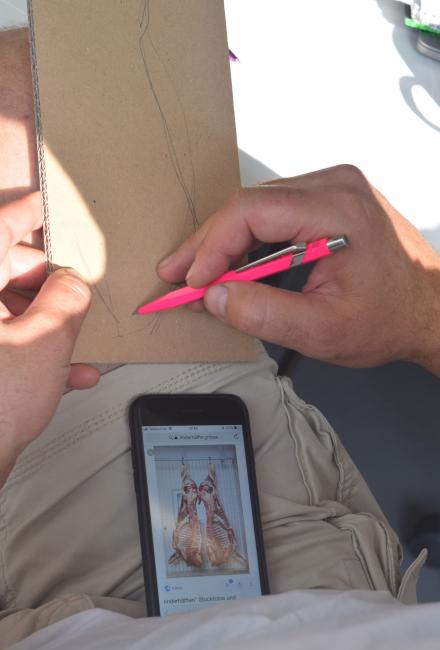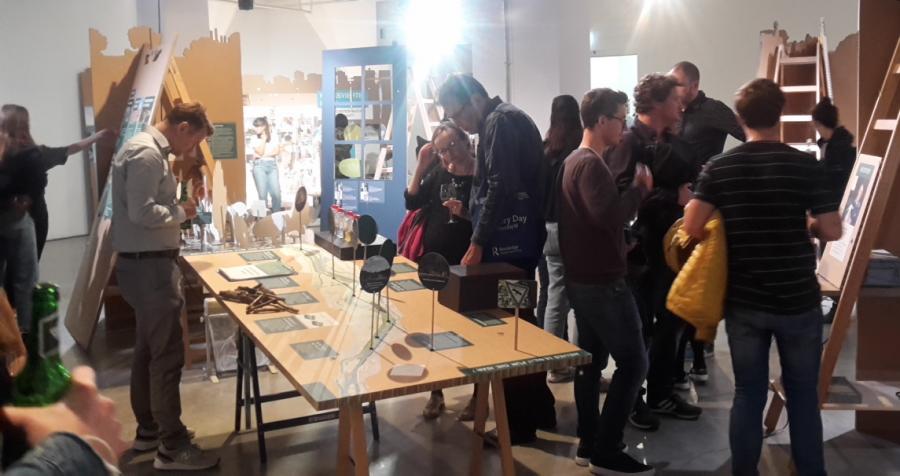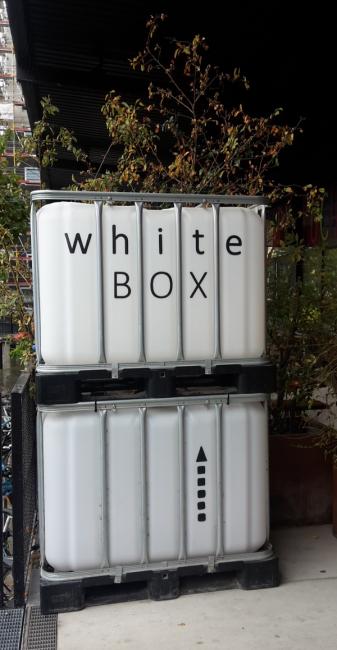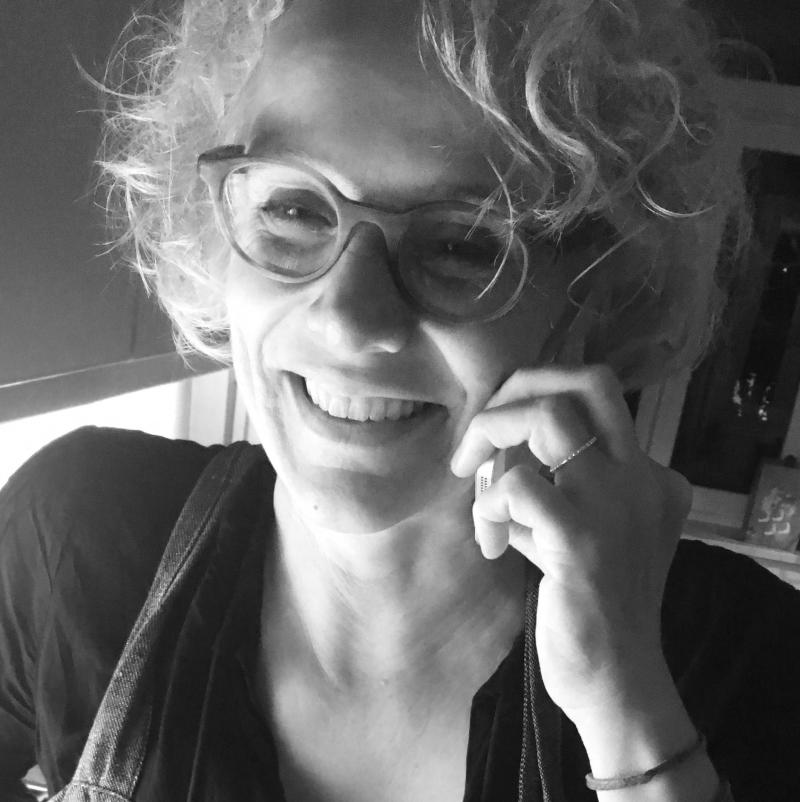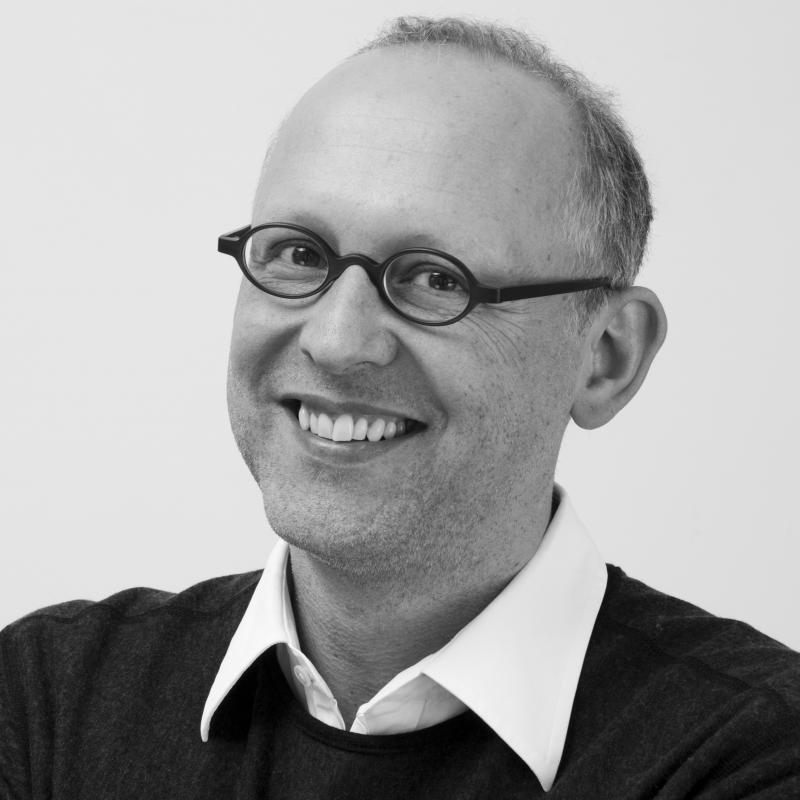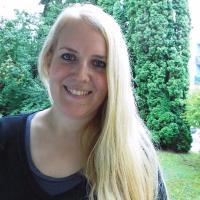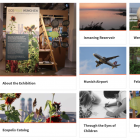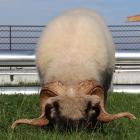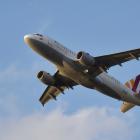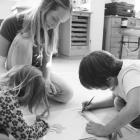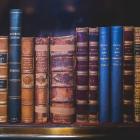About the Exhibition
- Rediscovering Munich’s environment: Introduction by Christof Mauch
- Environmental stories of discovery: Impressions from the exhibition
- Behind the scenes
- The Ecopolis München 2019 Team
- Acknowledgements
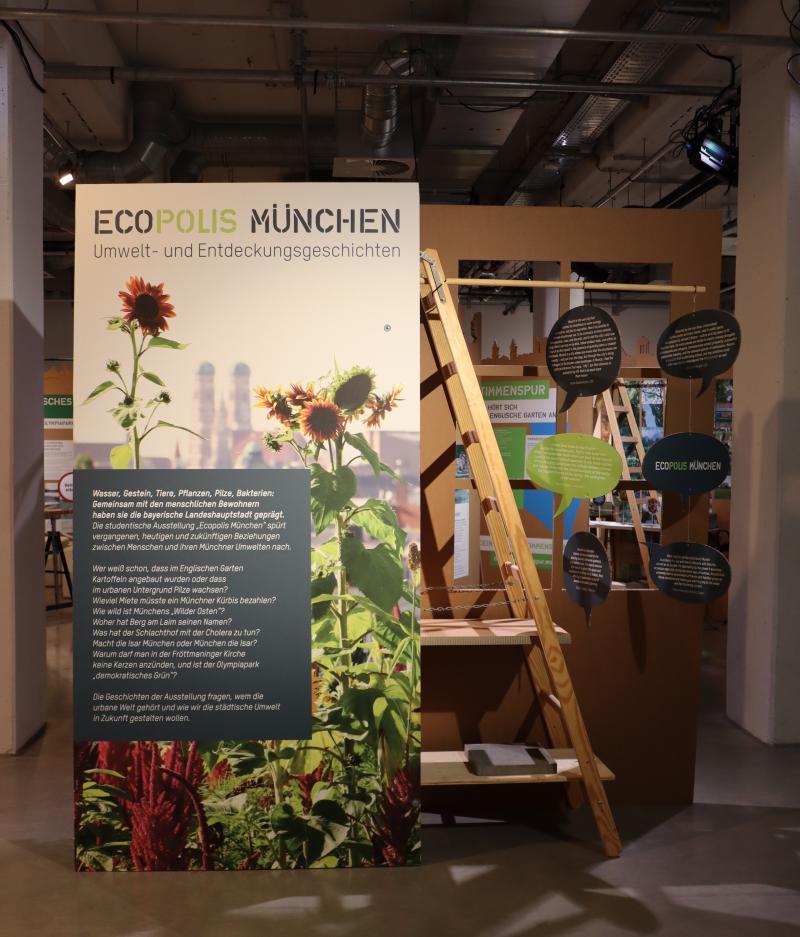
View of the start of the October 2019 exhibition at whiteBOX, a venue near Ostbahnhof in Munich.
View of the start of the October 2019 exhibition at whiteBOX, a venue near Ostbahnhof in Munich.
Photograph by Laura Kuen, 2019.
 This work is licensed under a Creative Commons Attribution 4.0 International License.
This work is licensed under a Creative Commons Attribution 4.0 International License.
One of the Rachel Carson Center for Environment and Society’s graduate programs is the Environmental Studies Certificate Program. The certificate program is open to all master’s students, Diplom students, and those studying Lehramt and towards their Staatsexamen. The program provides students with the opportunity to gain an additional interdisciplinary qualification in environmental studies. Ecopolis, an exhibition on Munich’s environmental histories, showcases the work of students in the RCC’s Environmental Studies Certificate Program. The first Ecopolis München exhibition, titled Ecopolis München: Environmental Histories of a City, was also organized by students from the Environmental Studies Certificate Program and took place in 2017. A virtual exhibition about the Ecopolis München 2017 exhibition can be found here. This second Ecopolis München exhibition is titled Ecopolis München 2019: Environmental Stories of Discovery.
Water and stone, animals, plants, fungi, bacteria: together with the human inhabitants they have left their mark on the Bavarian capital. Ecopolis Munich sets out in search of the past, present, and future relations between humans and their Munich environments.
Whoever knew that potatoes were once cultivated in the English Garden or that mushrooms grow in the urban underground? How wild is Munich’s “Wild East”? How did Berg am Laim get its name? What is the connection between the city slaughterhouse and cholera? Does the Isar shape Munich, or Munich the Isar? Why is it forbidden to light candles in the Fröttmaning church, and is the Olympic Park a “democratic green space”?
The stories told in this exhibition ask: to whom does the urban world belong? What do we want the urban environment of the future to look like?
Students formed multidisciplinary groups and prepared exhibits and presentations for the 2019 event in collaboration with the course leaders from the Rachel Carson Center. Mentors and lecturers include experts from different disciplines including Dr. Nina Möllers (program manager BIOTOPIA); Prof. Christof Mauch (environmental historian and Director of the Rachel Carson Center for Environment and Society), and many others.
In 2019, the RCC’s Environmental Studies Certificate Program has been awarded the LMU Munich’s Prize for Innovative Teaching for their work on the interactive and interdisciplinary exhibition “Ecopolis Munich: Environmental Stories of Discovery.” The exhibition is the end result of a rich and diverse seminar taught by lecturers from different disciplines, as well as close cooperation between students and professional designers and curators. The Program received the prize money of 10,000 Euro for future developments and presented the project at the University’s official end-of-year award ceremony. The focus of the event in 2019 was recognizing the importance of high-quality and accessible higher education.
1. Rediscovering Munich’s environment: Introduction by Christof Mauch
At first glance, Munich seems to be a very green city: the English Garden and the beaches along the Isar River, the park grounds around Nymphenburg Palace and the Olympic Park. While these features catch the eye, in reality, no other German city has so great a percentage of land sealed beneath concrete. And at first glance, Munich also seems to be a wealthy city. But the “Hauptstadt mit Herz,” the “capital with a heart” in which international tourists can find just about any aspect of German culture they desire—palaces and pork roast, dirndls, lederhosen and glockenspiel, BMW and beer—in fact only achieved this prosperity relatively recently.
If one wants to understand how Munich came to be the city it is today, a (historical) look at the relationship between humans and the environment will reveal many surprising insights. Precisely this is the ambition of the student exhibition “Ecopolis Munich.” The title reminds us that cities are not just political entities, but also complex ecosystems—including inanimate materials like stones and living organisms such as plants, animals, and bacteria. Without the Isar River the material used to build Munich’s infrastructure—wood, coal, and stone—could never have been transported from the Alps where it originated. Without the peat from the bogland of Erding, where the Munich airport is located today, the breweries would not have had access to inexpensive fuel, and without the slow movements of earth and stone during the glacial period tens of thousands of years ago that formed the Munich Gravel Plain, the glaciers whose pure runoff feeds Munich’s water supply would not exist, nor would the city’s underground system of streams and wastewater, nor the deep cellars for storing beer and potatoes, nor the underground tunnels that were at times used to grow mushrooms.
The 12 stations of “Ecopolis Munich” show how much natural factors affect everyday urban reality. And they demonstrate the ways that human planning and politics determine how our city functions and to what degree (and for whom) it provides socially just and sustainable living conditions. Why does the landscaping of the English Garden attempt to obscure the view of the city? What political ideas shaped the plans for the Olympic Park? Why is there an alpine sheep pasture in the middle of Munich and where does one find it? Why was an entire village buried beneath a mountain of rubbish? What significance does the Ismaning Reservoir have for the residents of Munich and for the local bird life? The students who created this exhibition set out as environmental detectives to answer these questions and others, and in the process, through keen observation, passion, and insight, they solved a number of perplexing mysteries.
“Ecopolis Munich” takes a close look at Munich’s past and present. The futuristic note of “ecopolis” reminds us that a good and responsibly lived life in the city can only be accomplished with the help of creative visions and a view to the future.
The exhibition was created in two stages. The first group of stations was developed in 2016 and 2017. In summer 2017 the exhibition was displayed in the main building of the university. The second group was put together in a fairly short amount of time during the summer semester of 2019. Here I would particularly like to acknowledge the students of the Environmental Studies Certificate Program whose research and ideas are expressed in the Ecopolis project. Additional thanks go to Laura Kuen, who contributed to the first exhibition as a student and to the second as a curator. Without Laura and without Dr. Gesa Lüdecke, the Director of our Graduate Studies, Ecopolis could never have become a reality. Thanks also to Talitta Reitz and Dr. Nina Möllers, who helped to make the seminar project a success, and particular thanks to our designers Katharina “Tinka” Kuhlmann and Alfred “Freddy” Küng, who supported us in 2017 and 2019 with their professional expertise as well as great enthusiasm! Finally, a source of constant gratitude to us is LMU Munich’s willingness to continue to host the Environmental Studies Certificate Program and the Rachel Carson Center, which has perhaps contributed more to interdisciplinary dialog at the university than any other institution.
The exhibition “Ecopolis Munich” could be viewed in person in October 2019 in the Werksviertel. In addition, it will continue to live on as a virtual exhibition on the Rachel Carson Center’s Environment & Society Portal. And maybe—so we hope—it will even serve as a source of inspiration for further projects about Munich’s environment.
Christof Mauch
Director of the Rachel Carson Center
2. Environmental stories of discovery: Impressions from the exhibition
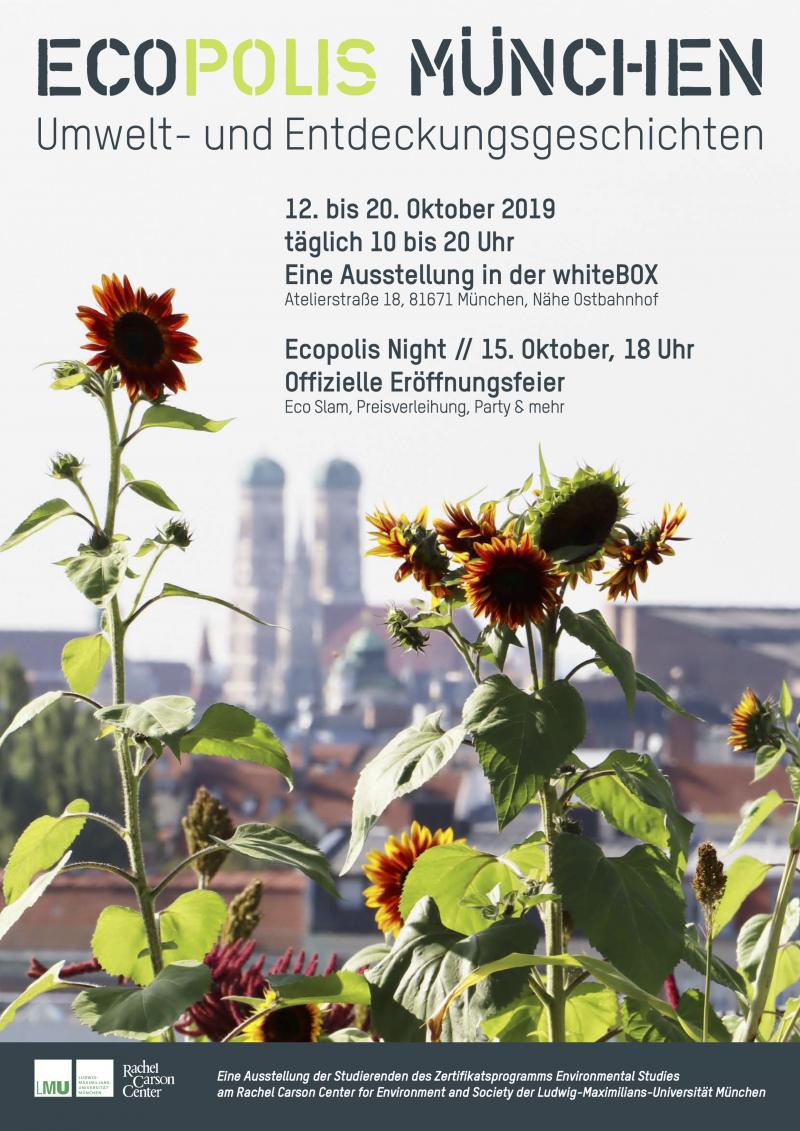
Poster for the exhibition.
Poster for the exhibition.
This poster was created by Laura Kuen.
 This work is licensed under a Creative Commons Attribution 4.0 International License.
This work is licensed under a Creative Commons Attribution 4.0 International License.
The exhibition ran from 12 October to 20 October 2019 at whiteBOX, a venue in the Werksviertel. The exhibition was part of Klimaherbst 2019. The Werksviertel-Mittel reported on the event, which can be read here (in German). They also produced a short video documentary (in German), which gives you an idea of what the physical exhibition was like, you can view it here or below. It is a creative, urban, and innovative space. It is an urban quarter in Munich that is constantly changing. In the east of Munich, living, working, entertainment, art, and culture blend into unique urban cooperation. It offers a space for grand architecture and digital, creative, and artistic innovations. Every day in the Werksviertel-Mitte, a lively urban culture unfolds, which everybody can actively help to shape and re-experience again and again.
3. Behind the scenes
As you can imagine, a lot of work goes into organizing an exhibition like this. Here we want to give you some glimpses behind the scenes and tell you the story of how this exhibition came together. In July 2019, the students in the certificate program met with their mentors, including Christof Mauch, Gesa Lüdecke, Laura Kuen, and the designers Katharina Kuhlmann and Alfred Küng, and presented their ideas of their stations. Later that month, the different groups met with the designers to develop ideas on how to present their ideas to the public.
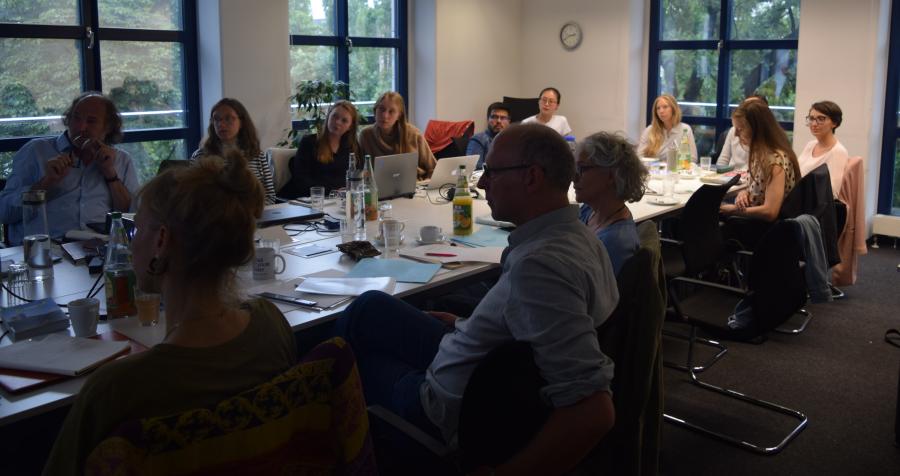
Planning and designing the Ecopolis München 2019 exhibition
On 13 July 2019, students of the Environmental Studies Certificate Program of the Rachel Carson Center meet with their mentors and the designers to discuss their ideas for the Ecopolis München 2019 exhibition.
Photograph by Laura Kuen. CC BY 4.0 international license.
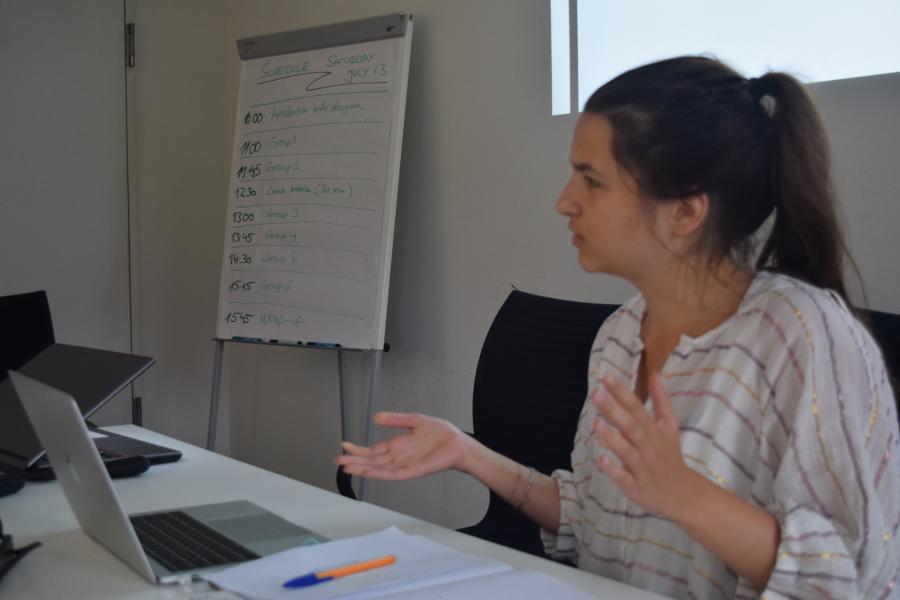
Here, Alisa Udodik presents her ideas for her station, “The Belly of Munich,” at the Ecopolis München 2019 exhibition.
Photograph by Laura Kuen. CC BY 4.0 international license.

Here, Johanna Mayer and Carolin Pichl discuss their ideas for their “StadtAcker” station with the designers Katharina Kuhlmann and Alfred Küng.
Photograph by Laura Kuen. CC BY 4.0 international license.
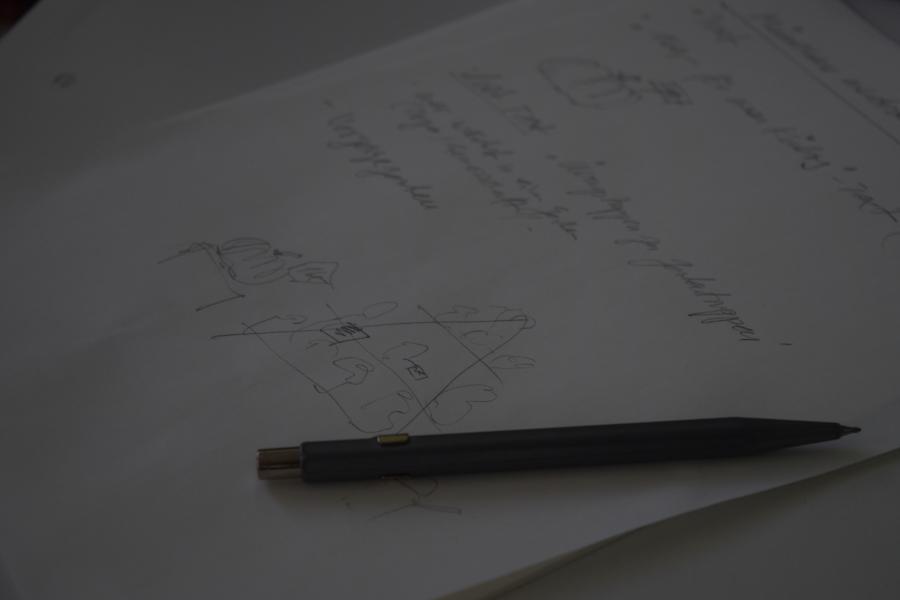
The designers, Katharina Kuhlmann and Alfred Küng, translate the students’ ideas into drafts on paper.
Photograph by Laura Kuen. CC BY 4.0 international license.
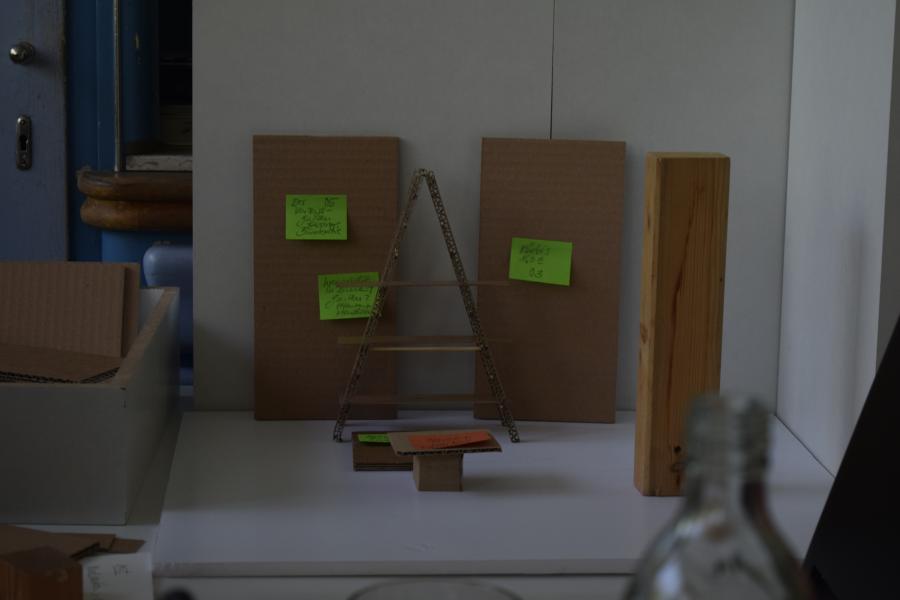
The designers Katharina Kuhlmann and Alfred Küng present to the students what their station might look like at the physical Ecopolis München 2019 exhibition.
Photograph by Laura Kuen. CC BY 4.0 international license.
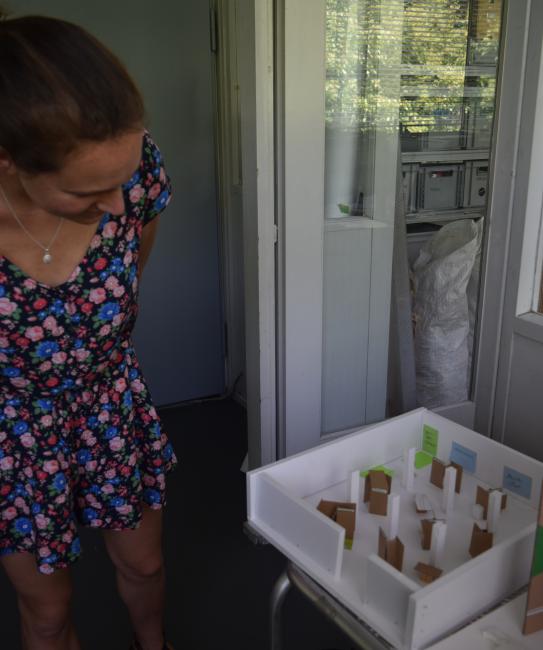
In a small box, the designers present how the twelve different stations will be arranged at the whiteBOX venue.
Photograph by Laura Kuen. CC BY 4.0 international license.
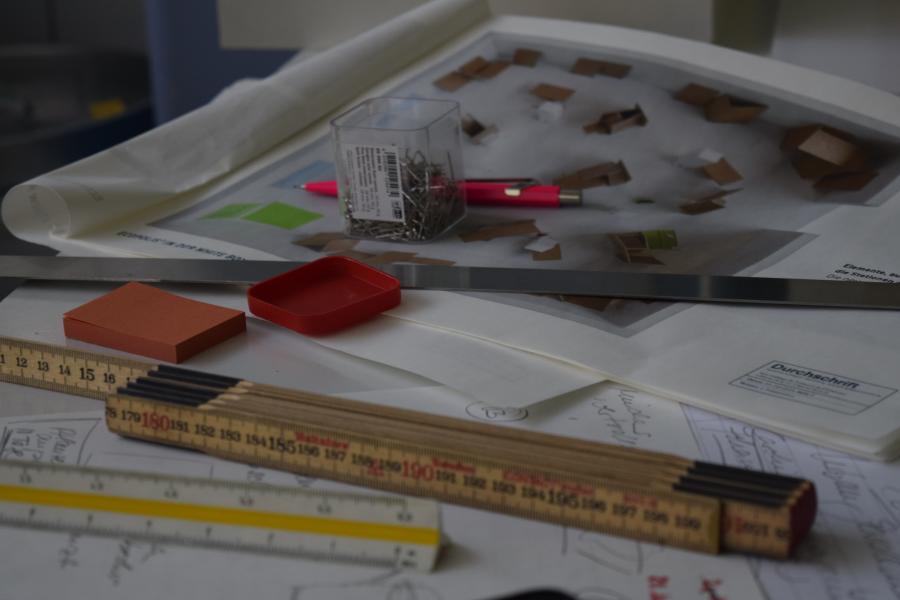
The designers Katharina Kuhlmann and Alfred Küng present their ideas to realize the Ecopolis München 2019 exhibition.
Photograph by Laura Kuen. CC BY 4.0 international license.
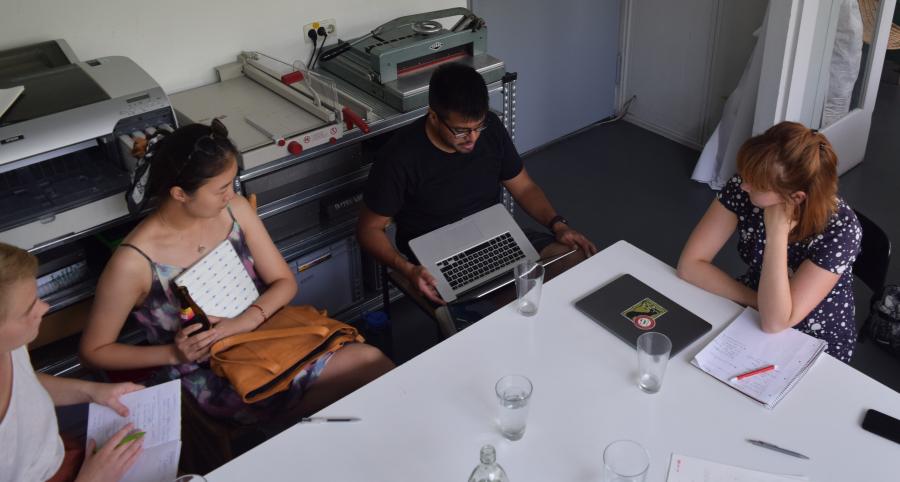
Johanna Felber, Hugo Reyes Aldana, and Xiao Wang discuss their ideas for the station “Munich Airport” with the exhibition’s curator Laura Kuen and the designers.
Photograph by Katharina Kuhlmann and Alfred Küng. Used with permission.
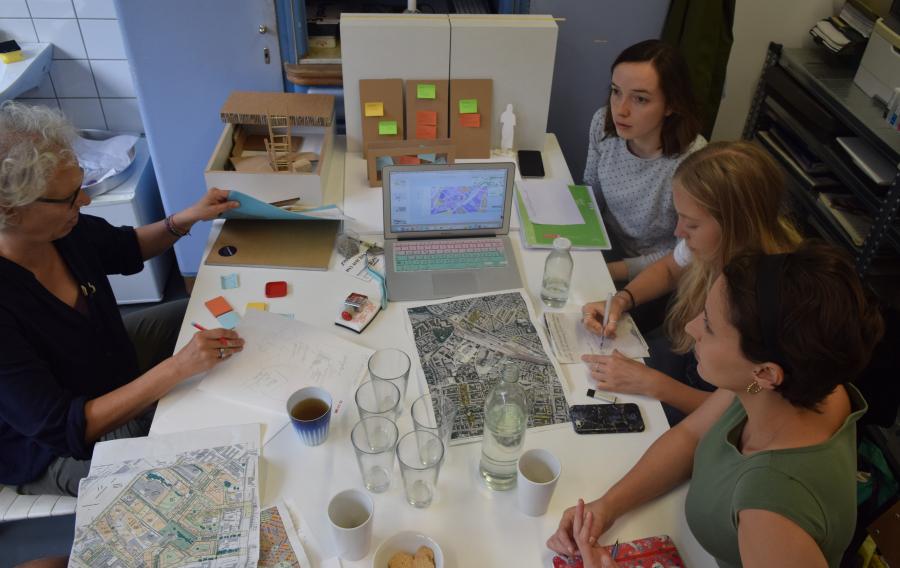
The group planning the station about the Werksviertel-Mitte, Helena Held, Vera Klünder, and Talitta Reitz, talk their ideas over with Katharina Kuhlmann and Alfred Küng.
Photograph by Laura Kuen. CC BY 4.0 international license.





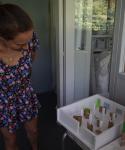




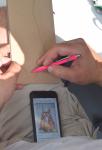
The students had visited the places of their research, hiked through the city or the thicket, observed and listened to the animals inhabiting the areas they researched, interviewed experts, and conducted research in books and archives. Once the writing, planning, clearing copyrights, and designing was done, the big day had come: It was time to set up the exhibition and to put the final touches on. All the students came together and put together all the installations and decorations. Now it was time to wait for the visitors to come—and the exhibition was a success.
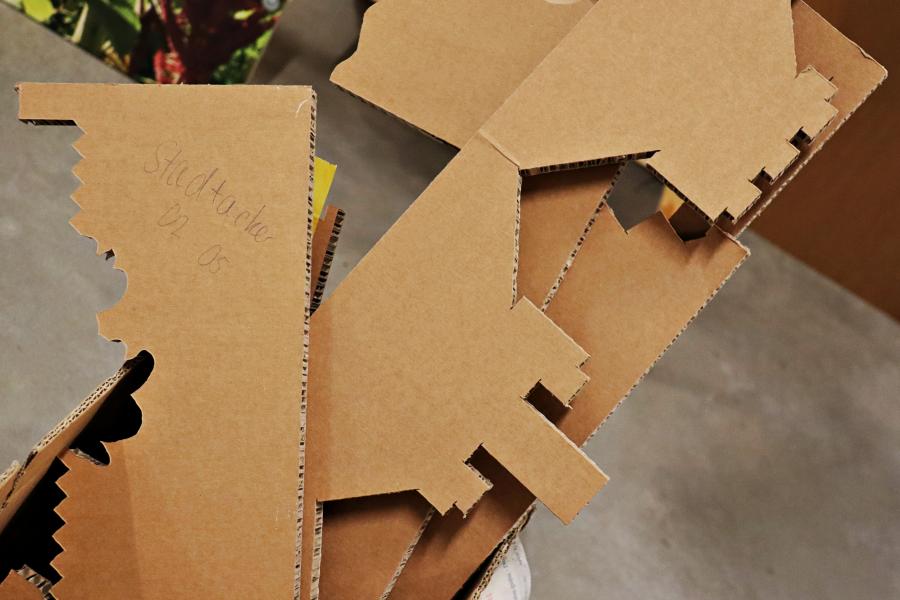
All hands on deck: setting up the Ecopolis München 2019 exhibition
Parts of the exhibits that still have to be set up at their right place.
Photograph by Laura Kuen. CC BY 4.0 international license.
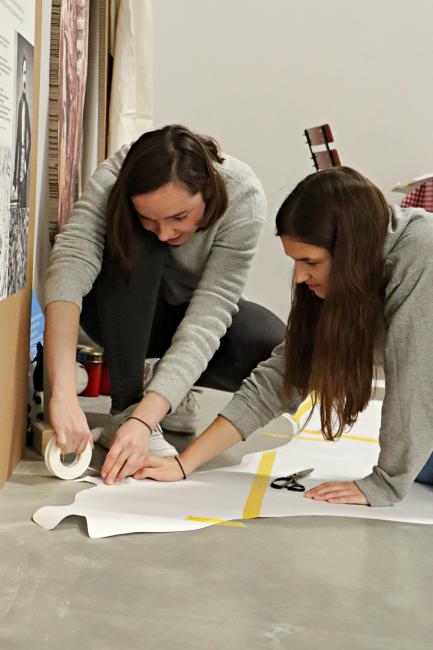
Students are in the process of setting up the exhibits.
Photograph by Laura Kuen. CC BY 4.0 international license.
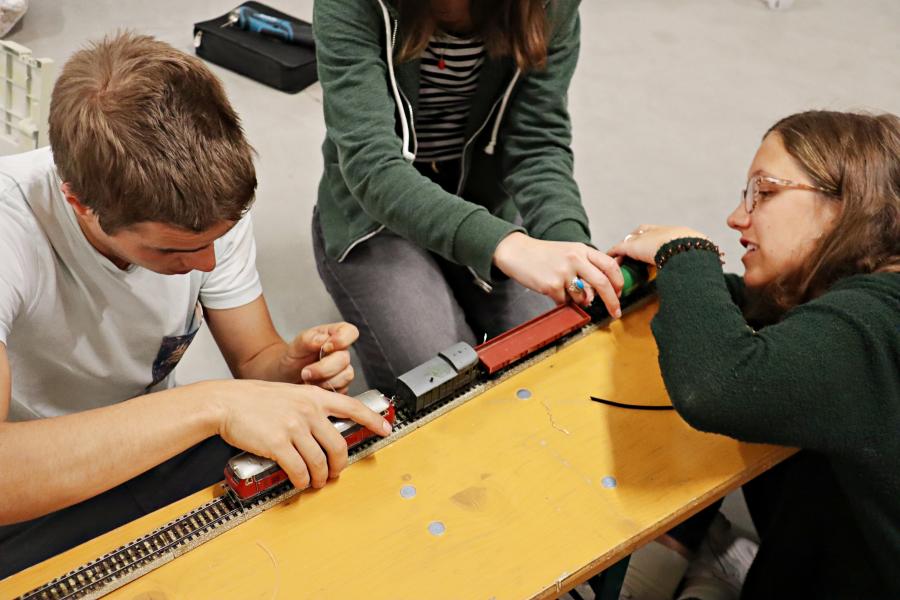
Students put together a model train that will accompany the “Former Railway Embankment Feldkirchner Tangente” station.
Photograph by Laura Kuen. CC BY 4.0 international license.
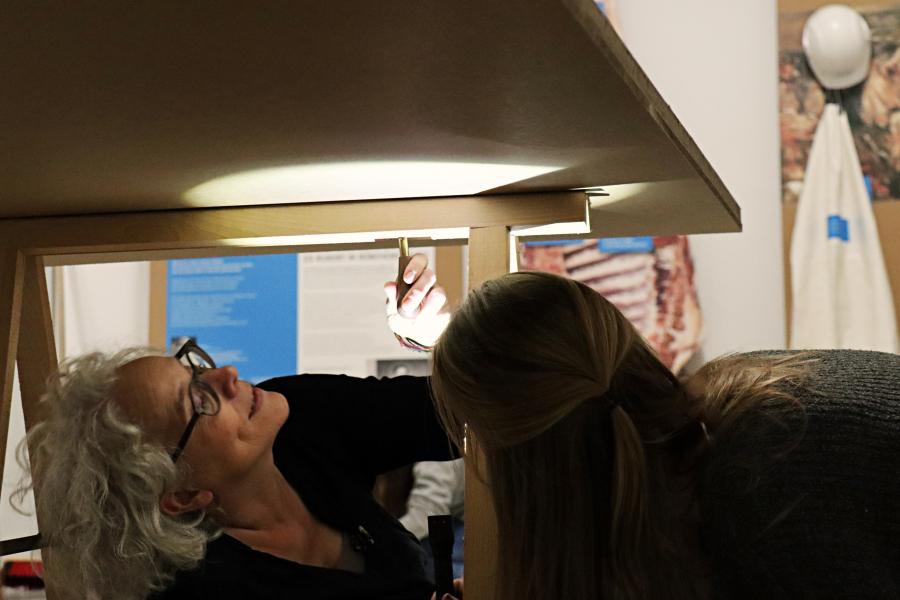
The designer Katharina Kuhlmann helps to set up the exhibits at the whiteBOX venue.
Photograph by Laura Kuen. CC BY 4.0 international license.
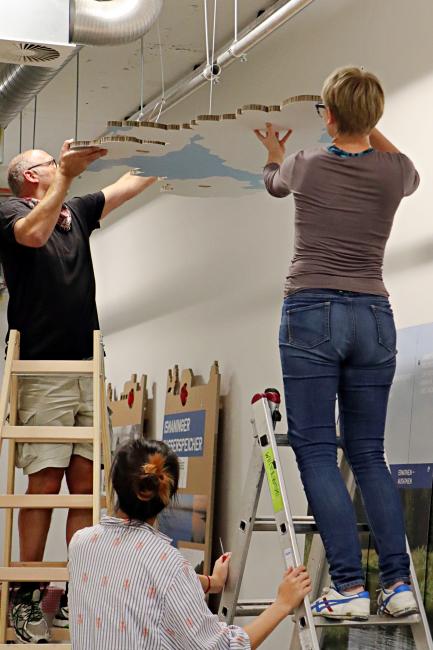
Students set up the exhibition at the whiteBOX venue. Here, students and Alfred Küng install the “sky” that will later hold the paper planes for the “Munich Airport” station.
Photograph by Laura Kuen. CC BY 4.0 international license.
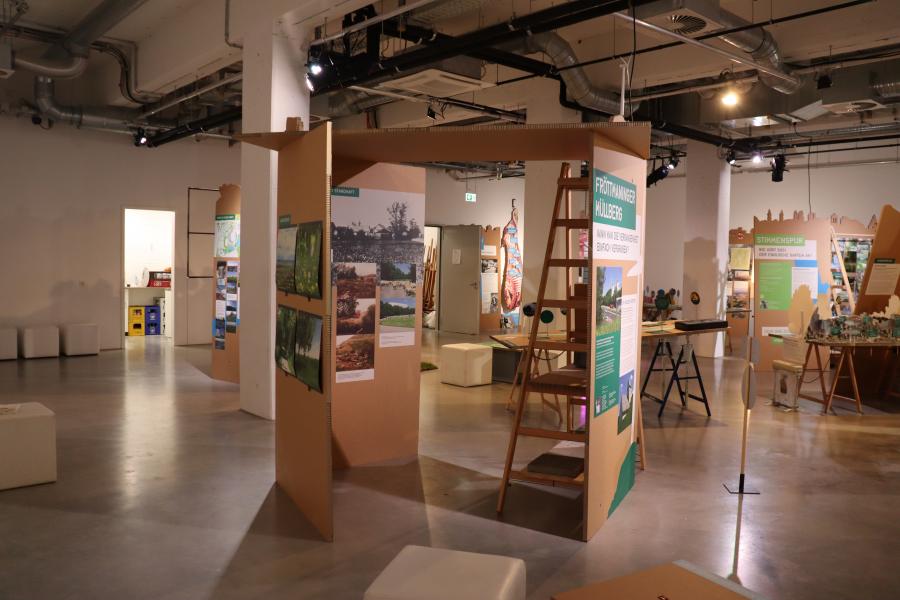
The different stations for the Ecopolis München 2019 have all been set up and the exhibition is now ready for the first visitors.
Photograph by Laura Kuen. CC BY 4.0 international license.

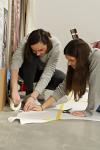


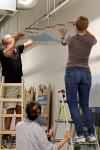



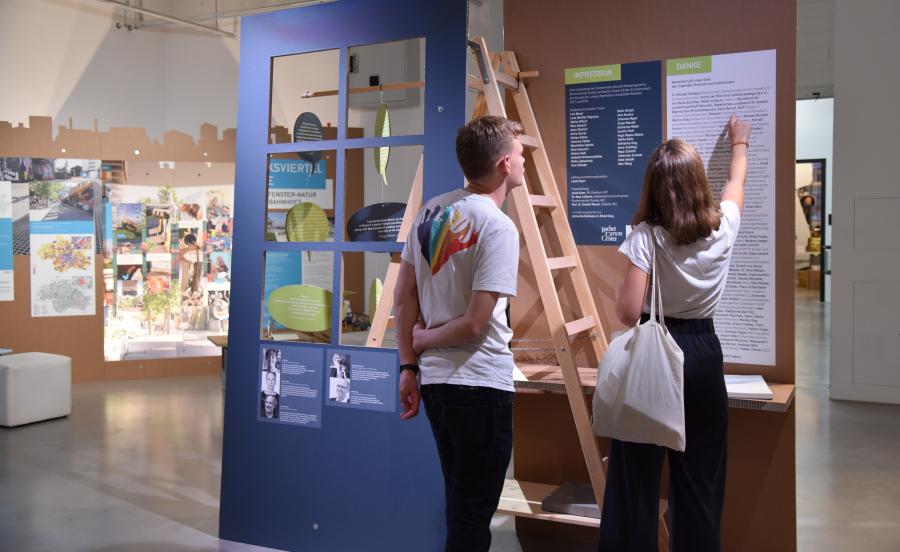
A glimpse of the Ecopolis München 2019 exhibition
Two visitors are reading the exhibits.
Photograph by Philipp Thalhammer, LMU Munich, 2019. Used with permission.
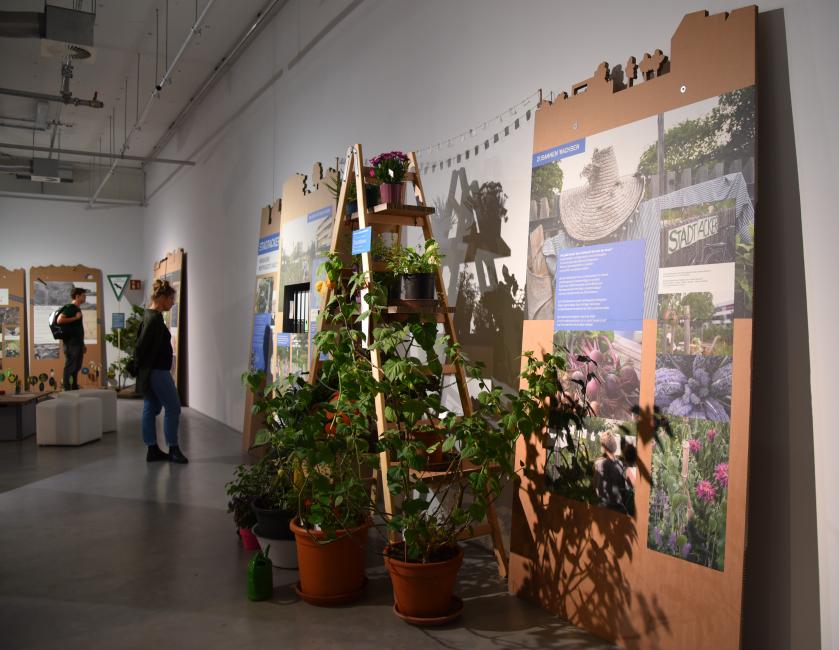
A glimpse of the physical Ecopolis München 2019 exhibition: This shows the “StadtAcker” station.
Photograph by Philipp Thalhammer, LMU Munich, 2019. Used with permission.
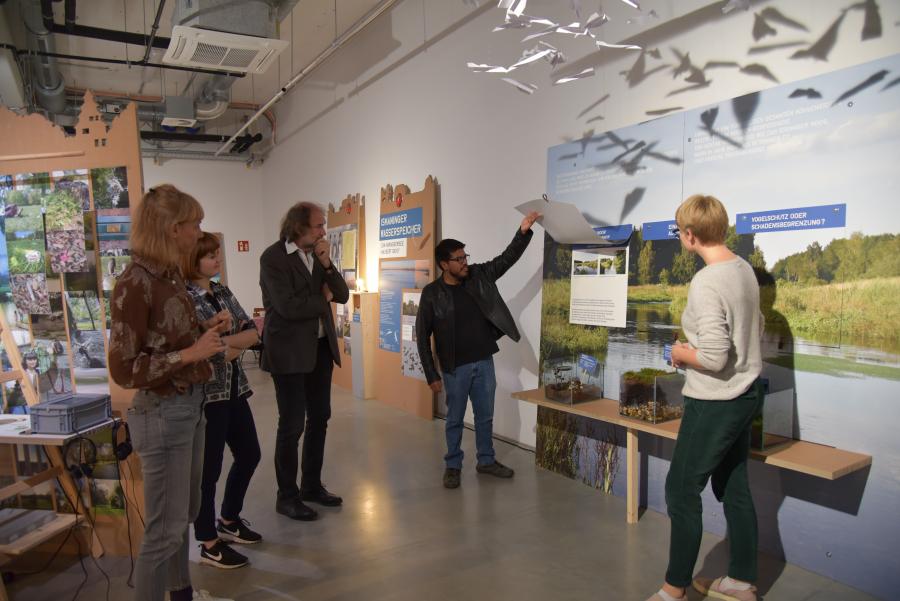
Here, Hugo Reyes Aldana explains the details of the “Munich Airport” station.
Photograph by Philipp Thalhammer, LMU Munich, 2019. Used with permission.
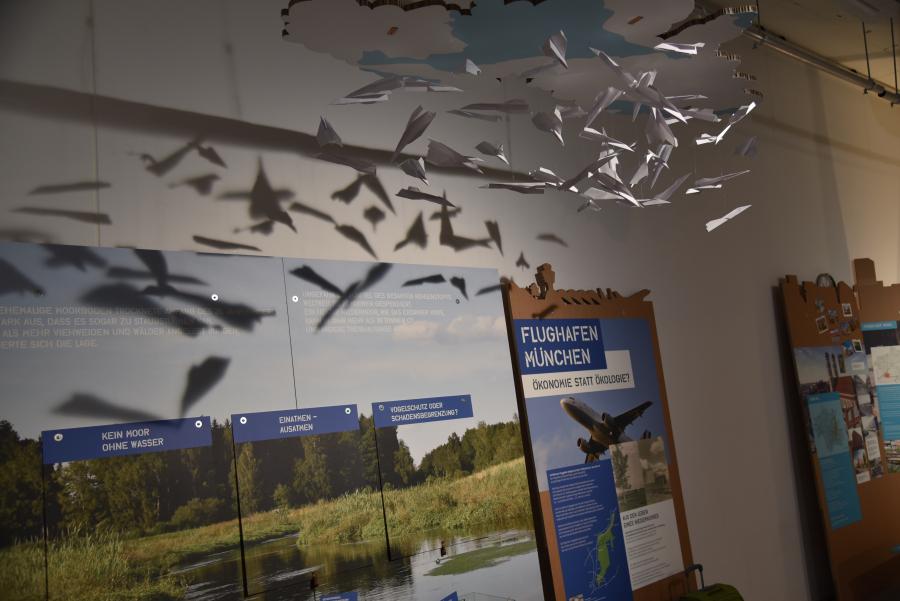
Paper planes at the “Munich Airport” station simulate the many airplanes that land at or take off from Munich Airport every day.
Photograph by Philipp Thalhammer, LMU Munich, 2019. Used with permission.
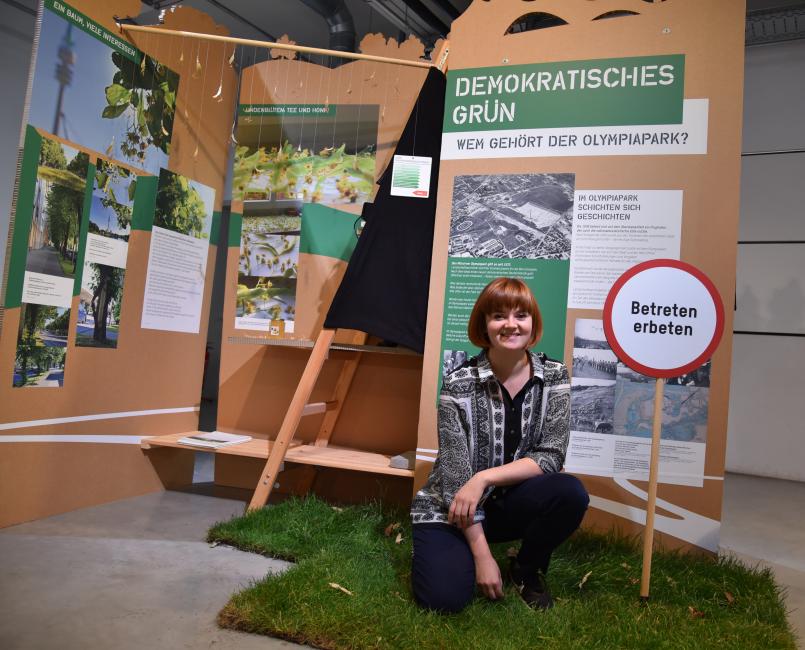
While this virtual exhibition highlights the six new stations that were created by student curators as their final projects as part of the Environmental Studies Certificate Program at the Rachel Carson Center, the physical exhibition also showed the six stations that were created for the previous Ecopolis München 2017 exhibition. These stations also represent the final projects of students from the Environmental Studies Certificate Program. Here, the curator Laura Kuen poses in front of the “Democratic Green” station. To learn more about this station, please see here.
Photograph by Philipp Thalhammer, LMU Munich, 2019. Used with permission.
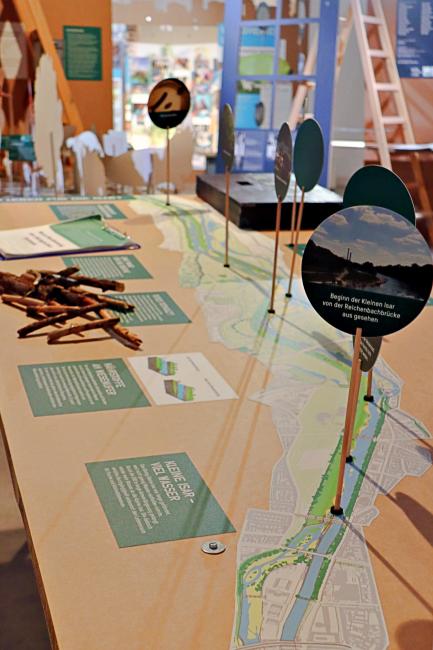
The “Munich and the Isar” station. To learn more about this station, please see here.
Photograph by Laura Kuen. CC BY 4.0 international license.
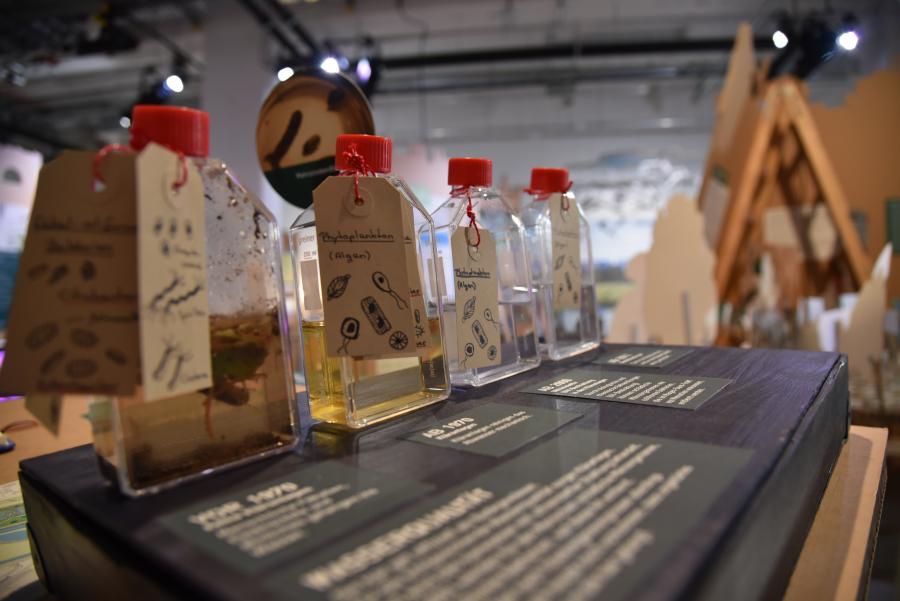
These items also represent a station titled “Munich and the Isar” that was originally created for the Ecopolis München 2017 exhibition. There were no purification plants along the river Isar. Human feces, food scraps, and the like, all contaminated the water. From left to right, the water becomes clearer due to water purification measures. To learn more about this station, please see here.
Photograph by Philipp Thalhammer, LMU Munich, 2019. Used with permission.
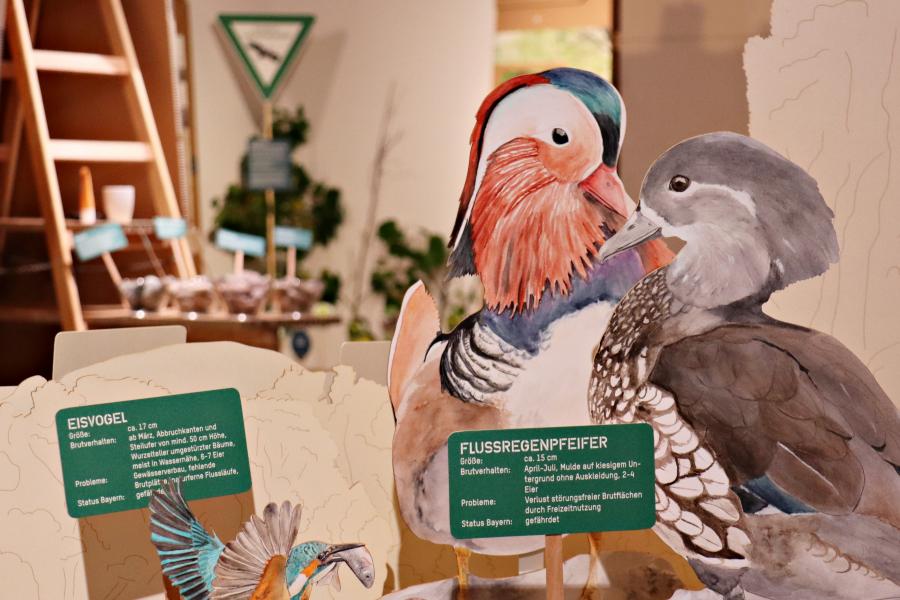
Another detail from the “Munich and the Isar” station. To learn more about this station, please see here.
Photograph by Laura Kuen. CC BY 4.0 international license.
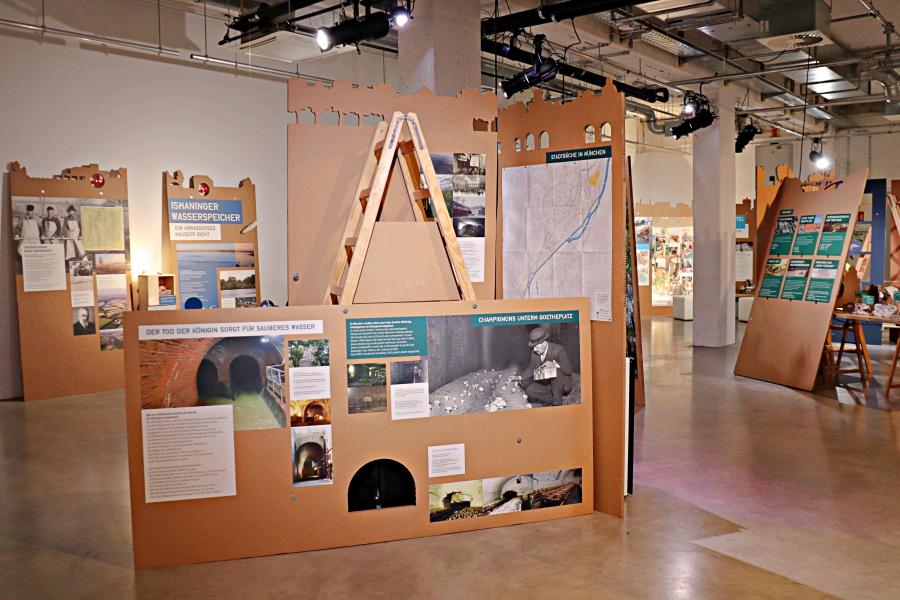
A glimpse at the physical Ecopolis München 2019 exhibition: Here you can see the “Munich from Below” station. To learn more about this station, please see here.
Photograph by Laura Kuen. CC BY 4.0 international license.
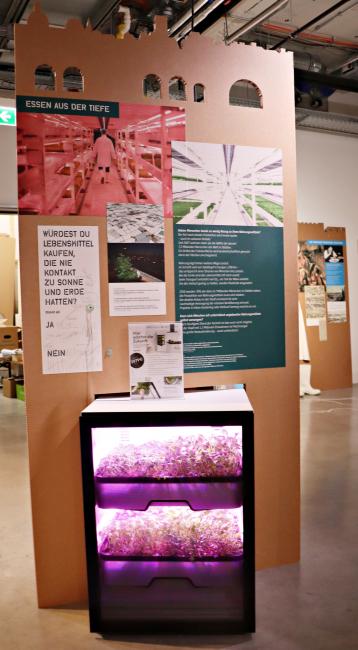
Another glimpse at the “Munich from Below” station that was originally created for the Ecopolis München 2017 exhibition. Food is being grown artificially here, without actual sunlight. To learn more about this station, please see here.
Photograph by Laura Kuen. CC BY 4.0 international license.
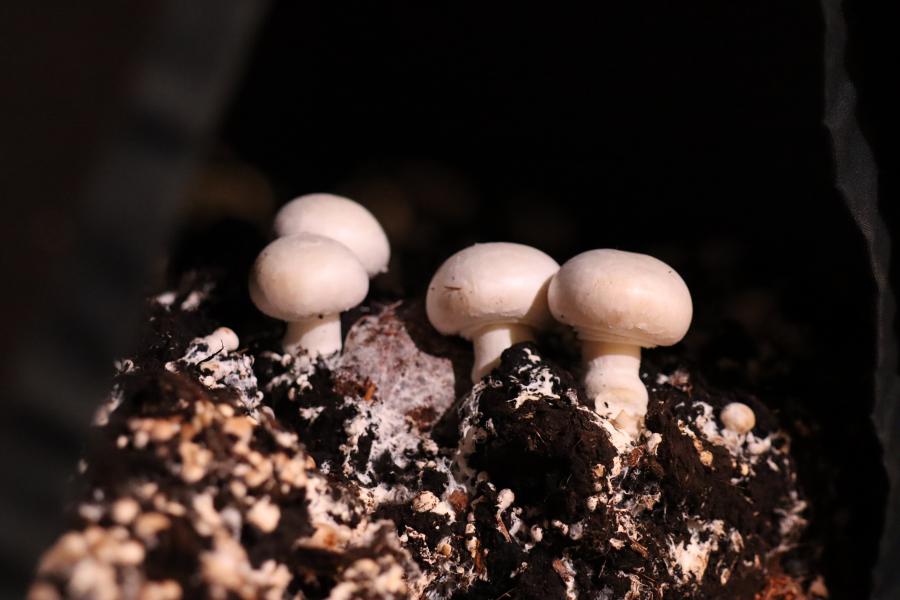
During the war, the subway shaft served as an air-raid shelter, and afterwards as a place for cultivating luxury food: button mushrooms. However, invasive ground water ended mushroom cultivation. To learn more about this station, please see here.
Photograph by Laura Kuen. CC BY 4.0 international license.
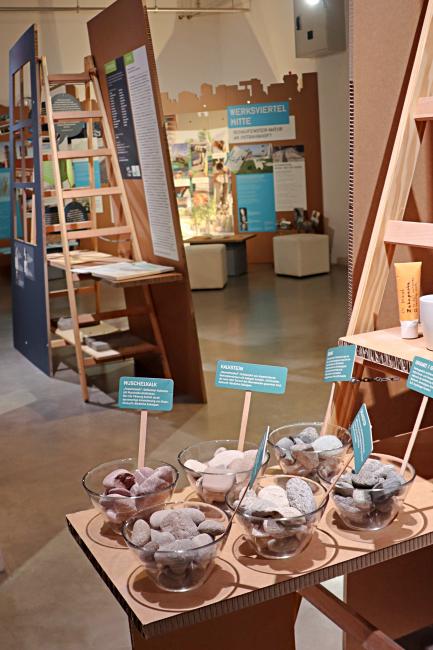
In the foreground, you can see part of the “Stone-Rich” station that had been originally created for the Ecopolis München 2017 exhibition. To learn more about this station, please see here.
Photograph by Laura Kuen. CC BY 4.0 international license.
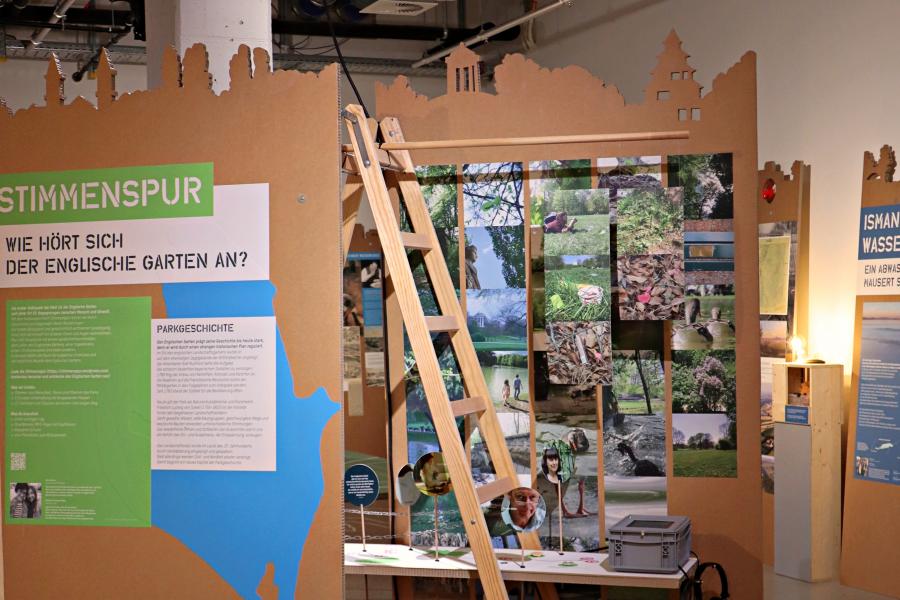
The “Sound Trail” station was also originally created for the Ecopolis München 2017 exhibition. To learn more about this station, please see here.
Photograph by Laura Kuen. CC BY 4.0 international license.

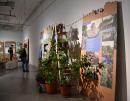



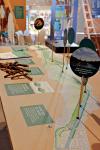





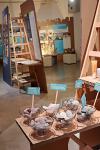

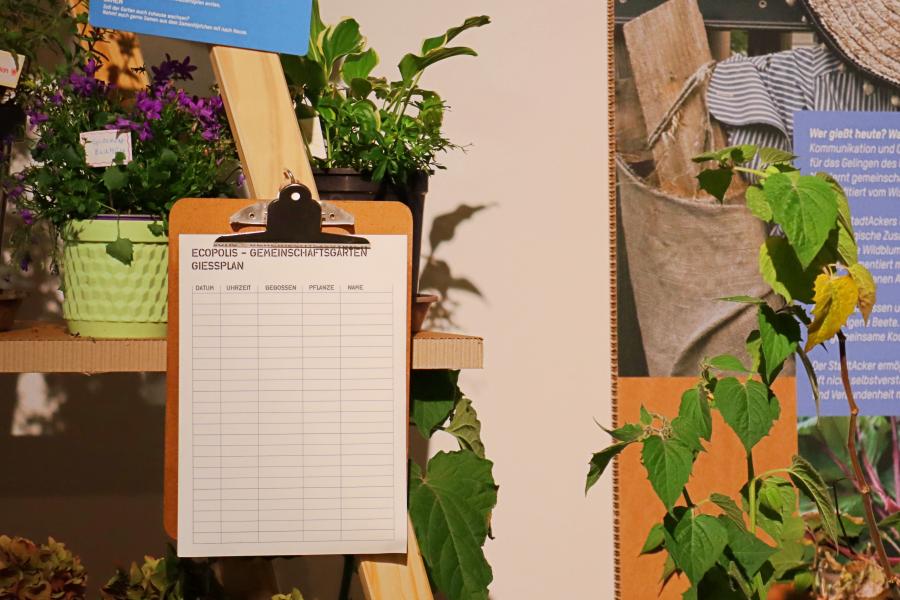
Interactive elements of the Ecopolis München 2019 exhibition
The physical Ecopolis München 2019 exhibition also includes some interactive elements. At the “StadtAcker” station, you could sign up for watering the plants.
Photograph by Laura Kuen. CC BY 4.0 international license.
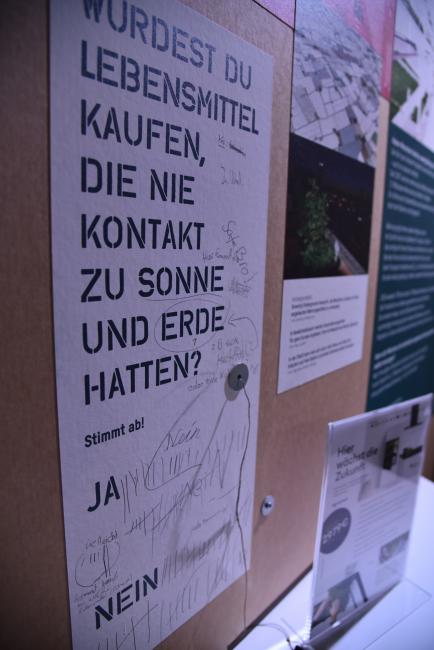
The physical Ecopolis München 2019 exhibition also includes some interactive elements. At the “Munich from Below” station, visitors could participate in a survey whether or not they would buy groceries that were grown inside buildings or below ground and have never been touched by sunlight or soil.
Photograph by Philipp Thalhammer, LMU Munich, 2019. Used with permission.
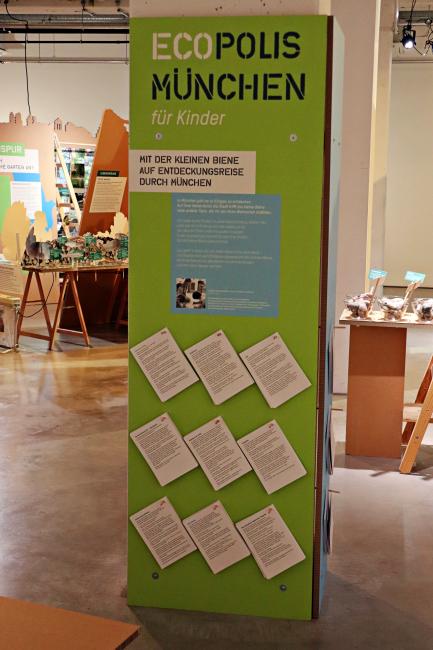
The physical Ecopolis München 2019 exhibition also included a station for younger visitors. Every station was told as a story for children. After an adult reads the stories to the children, they could draw their impressions on paper at a nearby table. This station was created by Isabelle Hermannstädter.
Photograph by Laura Kuen. CC BY 4.0 international license.

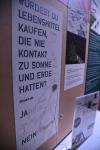
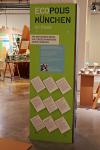
4. The Ecopolis München 2019 Team
The Student Curators
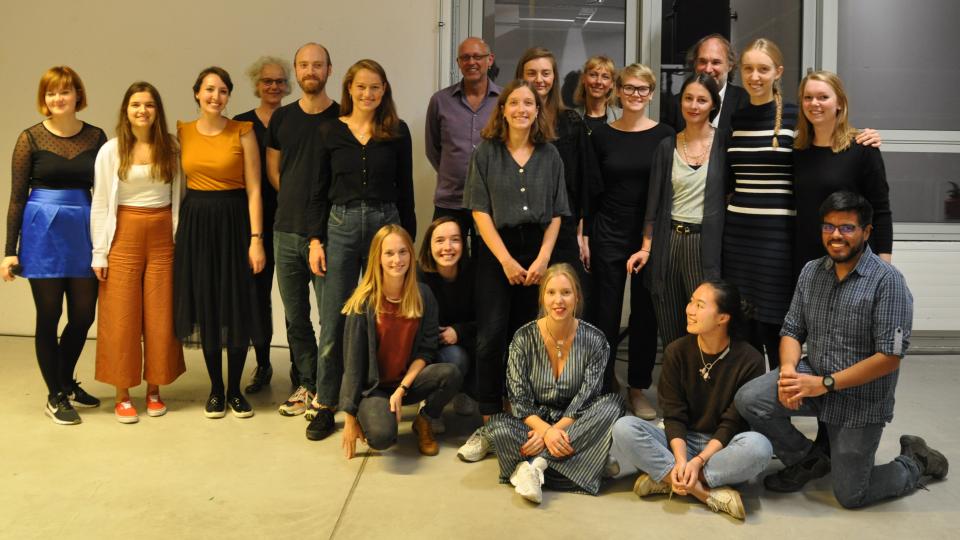
A group photo of the Ecopolis München 2019 team.
Hugo Reyes Aldana, Marc Bubeck, Anne Dietrich, Johanna Felber, Helena Held, Isabelle Hermannstädter, Maike Jebasinski, Malin Klinski, Vera Klünder, Laura Kuen, Katharina Kuhlmann, Alfred Küng, Gesa Lüdecke, Christof Mauch, Johanna Mayer, Carolin Pichl, Talitta Reitz, Anne Schilling, Alisa Udodik, and Xiao Wang.
A group photo of the Ecopolis München 2019 team.
Hugo Reyes Aldana, Marc Bubeck, Anne Dietrich, Johanna Felber, Helena Held, Isabelle Hermannstädter, Maike Jebasinski, Malin Klinski, Vera Klünder, Laura Kuen, Katharina Kuhlmann, Alfred Küng, Gesa Lüdecke, Christof Mauch, Johanna Mayer, Carolin Pichl, Talitta Reitz, Anne Schilling, Alisa Udodik, and Xiao Wang.
Photograph by Laura Kuen, 2019.
 This work is licensed under a Creative Commons Attribution 4.0 International License.
This work is licensed under a Creative Commons Attribution 4.0 International License.
Project Management
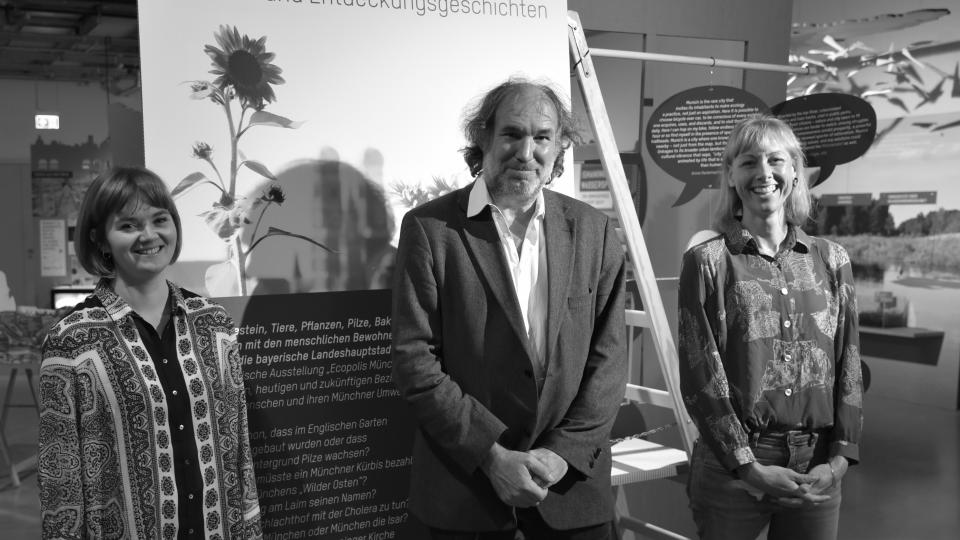
Laura Kuen, MA, curator, Rachel Carson Center for Environment and Society (RCC); Prof. Dr. Christof Mauch, director, RCC; Dr. Gesa Lüdecke, director of graduate programs, RCC.
Laura Kuen, MA, curator, Rachel Carson Center for Environment and Society (RCC); Prof. Dr. Christof Mauch, director, RCC; Dr. Gesa Lüdecke, director of graduate programs, RCC.
Photograph by Philipp Thalhammer, LMU Munich, 2019.
Used with permission.
The copyright holder reserves, or holds for their own use, all the rights provided by copyright law, such as distribution, performance, and creation of derivative works.
5. Acknowledgments
The essays and images on this website present an overview of the objects on display in the exhibition Ecopolis München: Umwelt- und Entdeckungsgeschichten, which was on view at the whiteBOX October 2019. This digital companion to the exhibition was prepared by Katrin Kleemann for the Environment & Society Portal. The exhibition was in German and all texts (including direct quotes) have been translated into English by Brenda Black.
Our gratitude goes to the following people and institutions:
Dr. Michael Altmayer (Bayerisches Staatsministerium für Umwelt und Verbraucherschutz)
Archiv der Münchner Arbeiterbewegung e.V.
Ana María Bastidas
Rebecca Bauer (Urkern)
Baureferat der Landeshauptstadt München
Bayerisches Landesamt für Umwelt
Bayerisches Wirtschaftsarchiv
Karin Bernst
BISS (Bürger in Sozialen Schwierigkeiten)
Boesner (Fachmarkt für Künstlerbedarf)
Markus Bräu (Referat für Gesundheit und Umwelt der Landeshauptstadt München)
Michael Brunner (Baureferat Gartenbau der Landeshauptstadt München)
Konrad Bucher (Koordinator StadtAcker)
Feliza Ceseña (Deutsches Museum, Abteilung Landwirtschaft und Ernährung)
DD (Dieter) Beck (Straßenmusiker)
Michael Degle (Bayerische Schlösserverwaltung)
Heidrun Eberle (Leitung Nachbarschafts-Börse am Ackermannbogen, Geschäftsführung Ackermannbogen e.V)
Christian Eckstein
Dr. Sophia Engel (LBV Kreisgruppe München)
Prof. Dr. Ignacio Farías
Anneliese and Martina Feser (shepherds)
Dr. Franz Freyberger (Kirchenpflege Pfarrverband St. Albert)
Dr. Nikolas Fricke (Nachhaltigkeit & Forschung Werksviertel Service)
Hubert Gerstacker (Lehrlingswart Metzger-Innung München)
Josef Glasl (Urkern)
Dr. Stefanie Gillhuber (Bayerischer Industrieverband Baustoffe, Steine und Erden e.V.) and colleagues
Sasha Gora (Rachel Carson Center for Environment and Society)
Green City e.V.
Growing Underground
Karin Haas (Gebietsbeauftragte LBV)
Ella von der Haide
Norbert Hans (Bunkerfreunde München)
Martin Hangen and Inge Kurr
Dr. Christine Heinz (Schlossmuseum Gemeinde Ismaning)
Ulrich Hilberer (Umweltabteilung Gemeinde Ismaning)
Raphaela Holzer (Haus der Bayerischen Geschichte Regensburg)
Dr. Gerhard Kabierske (Südwestdeutsches Archiv für Architektur und Ingenieurbau)
Serge Kaiser and colleagues (Ost-West Friedenskirche e.V.)
Prof. Dr. Regine Keller (Technical University of Munich)
Oliver Kern (Skiresort.de)
Christian Köbele (LBV Kreisgruppe München)
Dr. Peter Köhler (RAMSA Gruppe OG)
Annette Kolb (Gesellschaft der Freunde des Teeweges in der Bundesrepublik Deutschland e.V.)
Prof. Dr. Johannes Kollmann (Arbeitsgruppe Renaturierungsökologie, Technical University of Munich)
Peter Köstner (Kanalbetrieb der Münchner Stadtentwässerung)
Thomas Köster (Leitung Englischer Garten)
Roland Krack (NordOstKultur München)
Camilla Kraus
Hartmut Kuhl
Anita Kuisle
Günther Langer (Abfallwirtschaftsbetrieb München)
Heidrun Langer (Stadtführerin)
Matthias Langer (Rachel Carson Center for Environment and Society)
Sabine Laske and Evi Lichtenwald (Rumfordschlössl Natur- und Kulturtreff für Kinder und Jugendliche)
Sonja Lechner and Dankwart von Scotti
Klaus Leidorf
Hermann Grub and Petra Lejeune (Ein Englischer Garten e.V.)
Dr. Bernhard Lempe (Technical University of Munich)
Fritz Lietsch (Forum Nachhaltig Wirtschaften)
Maximilian Loessl (agrilution GmbH)
Loomit
Rudolf and Gerda Lukes
Dr. Anna Mazanik (Rachel Carson Center for Environment and Society)
Juliane Meister
Dr. Nina Möllers (BIOTOPIA Naturkundemuseum Bayern)
Thomas Oswald
Ingenieurbüro Patscheider and Partner
Wolfgang Pischek
Sandra Reinalter
Sven Riepe (Süddeutsche Zeitung)
Dr. Katie Ritson (Rachel Carson Center for Environment and Society)
Felix Remter
Ralf Sartori
Dr. Martin Saxer
Tobias Schiefer
Franz Schiermeier Verlag München
Dr. Stefan Schmidt (Bayerischer Kanu-Verband e.V.)
Dr. Hannelore Schnell (Leitungsteam StadtNatur)
Johannes Schnell (Landesfischereiverband)
Marion Schöne (Leitung Olympiapark) and colleagues
Gerhard Schwab (Bibermanagement Südbayern, BUND Naturschutz)
Heinz Sedlmeier (LBV Kreisgruppe München)
Issai Spitzer
Gärtnerkollektiv StadtAcker
Stadtarchiv Bad Tölz
Stadtmuseum Hadamar
Stadtmuseum München
Darko Stanic (Geschäftsführung Augustiner Keller München)
Monika Stey (Abendzeitung München)
Martin Summer
Oriana Taddeo
Franz Ulrich (Ulrich GmbH und Champignonzucht Wolnzach)
Fabian Unger (LBV Geschäftsstelle Wolfratshausen)
Christian Vogler (Wirt Augustiner Keller München) and Petra Vogler
Robert Völkl (Untere Naturschutzbehörde München)
Wasserwirtschaftsamt München
Wasserwirtschaftsamt Weilheim
Archiv Verlag Werner
Andreas Wöhl (Naturschutzgebiet Panzerwiese und Hartelholz)
Fabian Zimmer (Rachel Carson Center for Environment and Society)
and all those who have supported our project.
How to cite
Kleemann, Katrin, ed. “Ecopolis München 2019.” Environment & Society Portal, Virtual Exhibitions 2020, no. 2. Rachel Carson Center for Environment and Society. doi.org/10.5282/rcc/9005.
ISSN 2198-7696 Environment & Society Portal, Virtual Exhibitions
 2020 Edited by Katrin Kleemann
2020 Edited by Katrin Kleemann
This refers only to the text and does not include any image rights.
Please click on an image to view its individual rights status.
- Previous chapter
- Next chapter



